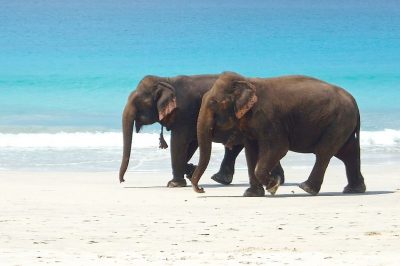Cancun Underwater Museum: A Sunken Museum Dedicated to Conserving Marine Life
Share

Cancun Underwater Museum, Isla Mujeres. (Ratha Grimes / Flickr)
The Cancun Underwater Museum is home to life-sized sculptures, which are devoted to the art of marine conservation. Known as MUSA or Museo Subacuatico de Arte in Spanish, the one-of-its-kind underwater museum is a non-profit organization located in Mexico’s southeastern coastal city of Cancun. The idea to start an underwater museum cropped up in 2008 when Jaime Gonzalez Canto noticed that the corals in Manchones Reef were being greatly damaged by tourist activities in the region. The director of the Marine Park in Isla Mujeres, which is an island in the Gulf of Mexico, then thought to seek Jason deCaires Taylor’s help to lure tourists away from the natural reefs. Jason deCaires Taylor stepped in to help. An award-winning Guyanan-British sculptor, certified scuba-diving instructor, underwater photographer and a marine conservationist, Taylor is also the founder of the world’s first underwater sculpture park in West Indies.
Jason deCaires Taylor and Gonzalez Canto started materializing their idea of the underwater park and their work began slowly in 2009. By November of the same year, Taylor submerged four of his concrete sculptures into the ocean, out of the initial five hundred planned in total. Later the next year, most of Taylor’s sculptures were placed three to six metres on the ocean floor, along with some more by local Mexican sculptors. By the year 2013, four hundred and eighty-seven of Taylor’s life-sized statues were added to the museum, which had officially opened to the public in the year 2010. Along with Taylor’s artwork titled ‘The Silent Evolution’, Mexican artists have also contributed to the museum, where more than a hundred million tourists visit in a single year.
The speciality of the Cancun Underwater Museum
Growing up in Malaysia and observing how nature reclaimed abandoned human environments, Jason deCaires Taylor worked on the idea of populating marine life, where humans had created the most destruction. He started making special, pH-neutral marine cement-based statues, which were ten times harder than the normal cement mix. Transforming this mixture of sand, micro silica, fibre glass and live coral into human forms, his sculptures were installed under the water, which would work as natural habitats for marine life, specifically coral reefs. Initially, artificial corals were placed on the sculptures, which soon began to lure in aquatic creatures and eventually, coral reefs began to flourish.

Cancun Underwater Museum. (Andy Blackledge / Flickr)
With a previous experience in building an underwater museum in Grenada, West Indies, Taylor’s new self-sustaining ecosystems in the form of human sculptures, took shape and some of his initial works started attracting a variety of tiny aquatic creatures. ‘The Silent Evolution’ also served a dual purpose. It eased the pressures off the natural coral reefs that were being affected by tourist activities like snorkelling and scuba diving and secondly, the visually-striking, porous, life-like statues were helping corals colonize the area quickly in a short span of time.
The underwater museum
Working with people from all sections of the society in Mexico, Jason deCaires Taylor took live casts of local people, with diverse features and expressions, sculpting them into statues, which now adorn the underwater museum. Going around Mexican cities looking for people to pose for his exhibition, Taylor picked up individuals – some carpenters, some accountants, a nun, a three-year-old boy, an acrobat – with extraordinary features to be his inspirations. He made use of giant cranes that transported these statues to the bottom of the ocean floor without either getting damaged themselves or harming nature in any way. Placed in two different galleries, one in Manchones Reef and the other in Punta Nizuc, these vivid human concrete sculptures are on display for snorkelers and scuba divers, who can view these large statues face-to-face. Tourists can also enjoy the view below of corals thriving on human-like figures in glass-bottomed boats.

A diver taking a selfie with an underwater sculpture. (Ratha Grimes / Flickr)
Statues at the Cancun Underwater Museum
Taylor’s stunning statues illustrate the human life and their association with nature. The first one to be submerged was the ‘La Jardinera de la Esperanza’ or the ‘Gardener of Hope’, which depicted a young girl lying in a garden amidst potted plants. Another amazing sculpture is titled ‘Sarah’, which is the only statue to have a pair of artificial lungs, fashioned after an English professor. Snorkelers can blow in bubbles or air from their tanks into the lungs, which later escapes from the open mouth of the sculpture, making it a rare sight to behold. Some statues are seen lost in conversation with each other, while others depict people deep in thought. Some individuals are seen grooming themselves while many others seem looking to the surface amid nothingness as if wanting freedom.

Underwater museum, Isla Mujeres. (Ratha Grimes / Flickr)
Planned initially at 350, 000 US dollars, the unique museum is made in such a way that it withstands frequent hurricanes, global warming and also hostile human activities. Turning eight this year, the spectacular statues are not only attracting marine animals and helping corals grow but also boosting tourism in the region, thus maintaining a symbiotic relationship between man and nature.
Enjoyed this article? Also, check out “Neptune Memorial Reef: An Eco-Friendly Underwater Graveyard Off the Florida Coast“.
Fact Analysis:
STSTW Media strives to deliver accurate information through careful research. However, things can go wrong. If you find the above article inaccurate or biased, please let us know at [email protected]













